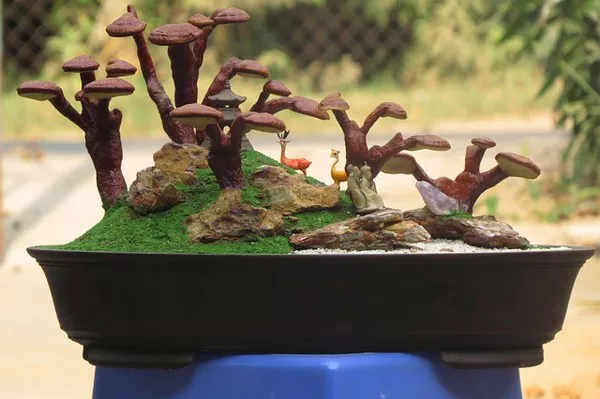Bonsai, the art of cultivating miniature trees, has captivated enthusiasts for centuries with its delicate balance of horticulture and artistry. While traditional bonsai often feature trees like junipers or maples, rose bonsai stands out as a unique and captivating variation. The fusion of the graceful rose with the disciplined techniques of bonsai creates a striking and enchanting display. In this comprehensive guide, we will explore the art of crafting a beautiful rose bonsai, from selecting the right rose variety to nurturing it into a masterpiece.
Choosing the Right Rose Variety
Selecting the appropriate rose variety is the first crucial step in creating a successful rose bonsai. Not all roses are suitable for bonsai cultivation, and certain varieties are better suited for this art form than others. Here are some characteristics to look for when choosing a rose variety:
Compact Growth Habit: Opt for rose varieties with a naturally compact growth habit. Miniature and patio roses are excellent choices, as they tend to have smaller leaves and shorter internodes, making them more adaptable to bonsai styling.
Continuous Bloomer: Roses that bloom consistently throughout the growing season are ideal for bonsai. This ensures that your bonsai remains adorned with flowers for an extended period.
Disease Resistance: Select disease-resistant rose varieties to minimize the need for constant pest and disease management.
Fragrance and Aesthetics: Consider the fragrance and appearance of the roses when making your selection. Choose varieties that appeal to your senses and fit your aesthetic vision for the bonsai.
Local Adaptation: If possible, choose rose varieties that are well-suited to your local climate and growing conditions. This will make it easier to care for your bonsai.
Preparing the Rose Cutting
Once you’ve chosen the right rose variety, it’s time to prepare a cutting for your bonsai project. Here’s a step-by-step guide to getting started:
Timing: The best time to take a cutting is during the dormant season, typically in late winter or early spring. Look for a healthy, disease-free branch with a diameter of about 1/4 to 1/2 inch.
Cutting: Using sharp, clean pruning shears, take a cutting that is about 6 to 8 inches long. Make a clean, slanting cut just below a leaf node.
Remove Leaves: Remove all the leaves from the cutting, leaving only a small set of leaves at the tip. This minimizes moisture loss through transpiration.
Rooting Hormone: Dip the cut end of the cutting in a rooting hormone to encourage root development. Follow the instructions on the product for the best results.
Planting: Plant the cutting in a well-draining potting mix or bonsai soil. Make a hole in the soil with a dibble or stick and insert the cutting, ensuring that at least one node is buried in the soil. Water thoroughly.
Humidity and Light: Place the potted cutting in a warm, humid environment with filtered sunlight. A plastic bag or a mini greenhouse can help maintain high humidity levels. Ensure the cutting receives indirect light to encourage root development.
Training and Shaping Your Rose Bonsai
Training and shaping your rose bonsai is where the true artistry of bonsai comes into play. Here are some essential techniques to consider:
Pruning: Regular pruning is essential to maintain the desired shape and size of your rose bonsai. Focus on removing dead or weak growth and shaping the branches to achieve the desired form.
Wiring: Use bonsai wire to gently bend and shape the branches. Be careful not to damage the delicate rose stems. Wiring should be done during the growing season when the branches are pliable.
Pinching: Pinch back new growth to encourage branching and a compact shape. Pinching should be done during the active growing season.
Repotting: Repot your rose bonsai every 2-3 years to refresh the soil and encourage healthy root growth. This is also an opportunity to inspect the root system and make any necessary adjustments to the bonsai’s design.
Fertilization: Fertilize your rose bonsai regularly during the growing season to ensure it receives the nutrients it needs for healthy growth and abundant flowering. Use a balanced, water-soluble fertilizer diluted to half the recommended strength.
Disease and Pest Control: Keep a close eye on your rose bonsai for signs of disease or pests, as roses can be susceptible. Prune and treat any affected areas promptly to prevent the issue from spreading.
Displaying Your Rose Bonsai
A well-crafted rose bonsai deserves to be displayed with pride. Consider these tips for showcasing your masterpiece:
Bonsai Pot: Choose an appropriately sized and aesthetically pleasing bonsai pot that complements the style and color of your rose bonsai. The pot should have drainage holes to prevent waterlogged roots.
Display Stand: Elevate your rose bonsai on a display stand to draw attention to its beauty. The stand can be made of wood, metal, or any material that complements your bonsai’s aesthetic.
Outdoor or Indoor: Depending on your climate and the rose variety you’ve chosen, you can display your rose bonsai either outdoors or indoors. Some rose bonsais thrive best when they can experience the seasonal changes of the outdoors, while others may prefer the controlled environment of your home.
Rotation: Periodically rotate your bonsai to ensure even growth and sunlight exposure. This helps maintain a balanced and symmetrical appearance.
Conclusion
Crafting a stunning rose bonsai is a rewarding journey that combines the elegance of roses with the precision and artistry of bonsai. By carefully selecting the right rose variety, preparing a healthy cutting, and diligently training and shaping your bonsai, you can create a living work of art that will bring beauty and serenity to your surroundings for years to come. Remember that patience and dedication are essential in the world of bonsai, and with time and care, your rose bonsai will flourish and thrive, becoming a testament to the artistry of nature and human hands.


